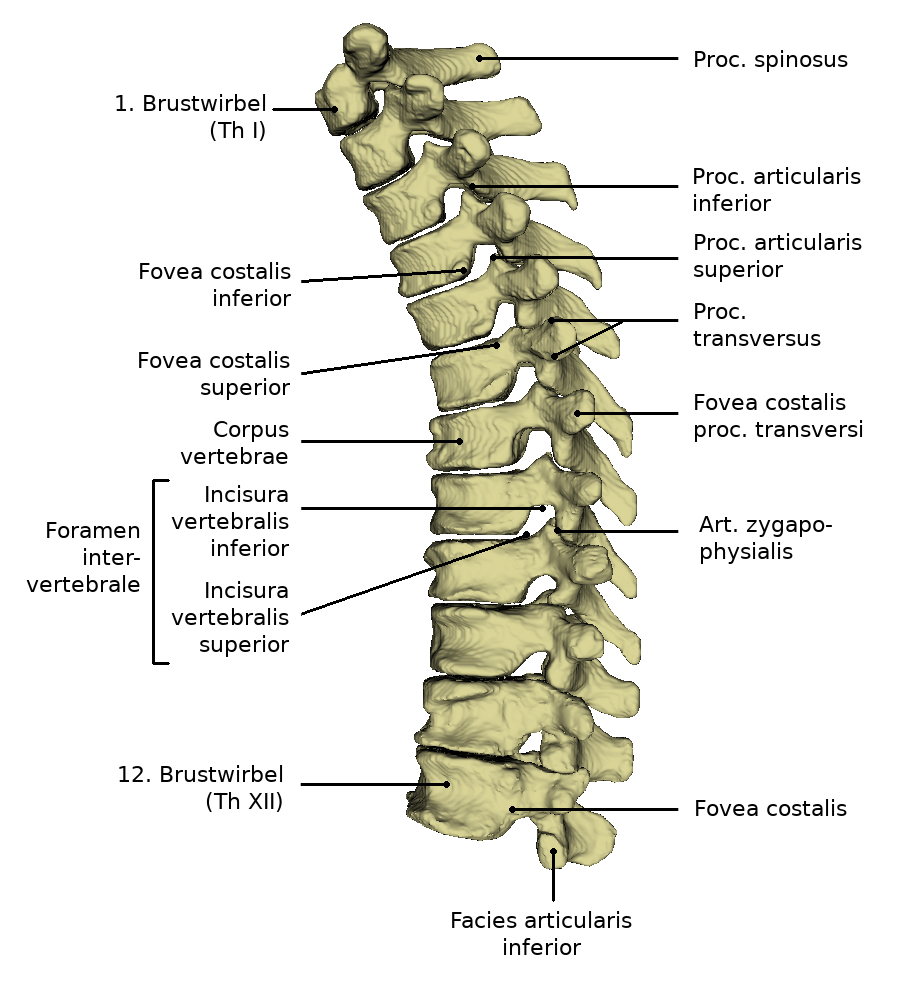Brustwirbelsäule/en: Unterschied zwischen den Versionen
(Die Seite wurde neu angelegt: „The ribs are connected to the thoracic vertebrae. The uppermost joint pit for the first rib is completely supported by the first thoracic vertebra. Half of the…“) |
(Die Seite wurde neu angelegt: „==Movement==“) |
||
| Zeile 54: | Zeile 54: | ||
The ribs are connected to the thoracic vertebrae. The uppermost joint pit for the first rib is completely supported by the first thoracic vertebra. Half of the joint cavity for the second rib is also located at this vertebra. At the upper and lower edges of the second to ninth thoracic vertebrae, there is a flat socket each, which together with the adjacent thoracic vertebra forms the articular surface for a rib head. The lower half of the articular cavity of the tenth rib is located on the upper side of the eleventh thoracic vertebra. The entire socket of the eleventh rib is also supported by the eleventh thoracic vertebra. The entire socket of the twelfth rib is also located on the twelfth thoracic vertebra. | The ribs are connected to the thoracic vertebrae. The uppermost joint pit for the first rib is completely supported by the first thoracic vertebra. Half of the joint cavity for the second rib is also located at this vertebra. At the upper and lower edges of the second to ninth thoracic vertebrae, there is a flat socket each, which together with the adjacent thoracic vertebra forms the articular surface for a rib head. The lower half of the articular cavity of the tenth rib is located on the upper side of the eleventh thoracic vertebra. The entire socket of the eleventh rib is also supported by the eleventh thoracic vertebra. The entire socket of the twelfth rib is also located on the twelfth thoracic vertebra. | ||
| − | == | + | ==Movement== |
Durch Rippen-Wirbel-Gelenke ist es möglich den Brustkorb zu bewegen. Der Brustkorb kann sich dadurch beim Atmen zusammenziehen und wieder ausdehnen. Die Interkostalgelenke werden durch die Wirbel und die anschließenden Rippen gebildet. <br> | Durch Rippen-Wirbel-Gelenke ist es möglich den Brustkorb zu bewegen. Der Brustkorb kann sich dadurch beim Atmen zusammenziehen und wieder ausdehnen. Die Interkostalgelenke werden durch die Wirbel und die anschließenden Rippen gebildet. <br> | ||
Version vom 27. Mai 2020, 14:26 Uhr
The spinal section between cervical spine and lumbar spine is the thoracic spine (BWS). It consists of twelve structure of a vertebrae. These are stronger than the vertebrae in the cervical spine. The thoracic spine represents the longest part of the spinal column. Together with the ribs and sternum, the thoracic spine forms the bony thorax.
Anatomy
The thoracic vertebrae follow after the seventh cervical vertebra. Caudally of the twelfth thoracic vertebra the lumbar spine follows. In healthy people, the thoracic spine is bent backwards, which is known as physiological kyphosis.
The thoracic vertebrae are stronger in comparison to the cervical vertebrae. They become stronger and more stable after caudally to bear the increasing body load. Seen laterally, the middle thoracic vertebrae have a lower height than the upper and lower thoracic vertebrae. The front side of the vertebrae is slightly higher than the back side. The surface facing the chest has a slightly hollowed out hollow. The spinous processes on the thoracic spine are long and triangular. They lie on top of each other like roof tiles, closing the gaps between the vertebral arches. Compared to the cervical and lumbar spine, the Foramen vertebrale is almost round and somewhat smaller. The transverse processes are bent away dorsally, thus creating space for the joint surfaces at the vertebral bodies and at the transverse processes.
Between two vertebrae there is an intermediate hole. The spinal nerves run through this. At the level of the thoracic spine, these nerves innervate the rib cage, the corresponding muscles and the outer and inner skin of the chest wall.
The ribs are connected to the thoracic vertebrae. The uppermost joint pit for the first rib is completely supported by the first thoracic vertebra. Half of the joint cavity for the second rib is also located at this vertebra. At the upper and lower edges of the second to ninth thoracic vertebrae, there is a flat socket each, which together with the adjacent thoracic vertebra forms the articular surface for a rib head. The lower half of the articular cavity of the tenth rib is located on the upper side of the eleventh thoracic vertebra. The entire socket of the eleventh rib is also supported by the eleventh thoracic vertebra. The entire socket of the twelfth rib is also located on the twelfth thoracic vertebra.
Movement
Durch Rippen-Wirbel-Gelenke ist es möglich den Brustkorb zu bewegen. Der Brustkorb kann sich dadurch beim Atmen zusammenziehen und wieder ausdehnen. Die Interkostalgelenke werden durch die Wirbel und die anschließenden Rippen gebildet.
Durch die Brustwirbelsäule wird eine Seitwärtsneigung von etwa 30° im Oberkörper ermöglicht. Diese Bewegung wird durch die Rippen begrenzt, die ab einem bestimmten Punkt aufeinander treffen.
Die Rotationsbewegung des Rumpfes um die eigene Achse wird auch durch die Brustwirbelsäule unterstützt. Die Rotation ist bis zu 33° möglich.
Funktion
Durch die Brustwirbelsäule wird der Rumpf stabilisiert. Die einzelnen Rippen werden durch die Wrustwirbeläule gehalten. Da die Brustwirbelsäule am Aufbau des Thorax beteiligt ist, werden die darin liegenden Organe durch die Brustwirbelsäule geschützt. Auch in diesem Teil der Wirbelsäule wird das Rückenmark durch die Wirbel geschützt.












